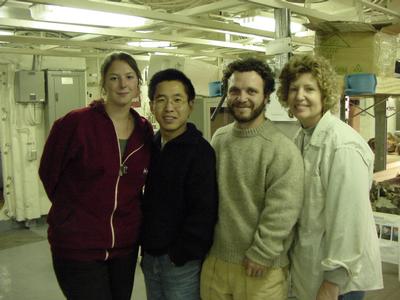11 September, 2001
September 11, 2001
A Foreign Exchange
Over the last few days, scientists aboard the Healy and Polarstern have been
trading places. Several scientists aboard each ship have learned about life
and science aboard the neighboring icebreaker.
Two scientists from the Healy-Linda Kuhnz and Gad Soffer, spent several days
aboard the Polarstern. Although the Germans are mapping and dredging as we
are, they are collecting and analyzing data from Gakkel Ridge by other means
as well. One piece of equipment they use is called a "TV Grab". This
equipment uses a camera to view the ocean floor to facilitate rock
collection. As the scientists work on the ship, it gives them "eyes" on the
bottom. A second piece of equipment used on the Polarstern is called
"OFOS". This system enables scientists to illuminate and videotape the
seafloor by moving a camera along the bottom.
With 45 scientists on board the Polarstern, they have projects going on
besides the study of rocks. There are studies occurring on weather, ice
thickness, and sediment, to name a few. The 2 scientists from the Healy
parcticipated in a variety of projects. Gad spent time looking at thin
sections of rocks. This is where rocks samples are cut paper thin and
viewed under a special microscope called a petrographic microscope. By
using polarized light, it exposes the minerals and textures within the
rocks. It can reveal information about the rock's "life" by its crystal
patterns. Linda was able to fly in a German helicopter and land on the ice
to collect samples of organisms. She laid down on the ice and leaned over
the side to obtain several species of algae living on the underside. She
collected phytoplankton, too. The specimens were preserved and will be
taken for close analyzation to the lab where she works in California.
Overall, the American scientists had a wonderful exchange experience aboard
the Polarstern (besides the great learning and sharing experience, Gad also
enjoyed their swimming pool and sauna).
So what did the German scientists do aboard the Healy? Our visitors were
given the opportunity to learn how we run our program. They were involved
in every aspect of what happens here on a daily basis from map-making to
analyzing rocks. It was truly a learning experience for them to compare and
contrast methods and work with our scientists.
The experience of living and working on a foreign vessel provides great
opportunities for all involved. The successful exchanges what have occurred
in the last few days have certainly been valuable to the scientists, and
this will hopefully encourage more such activities during the remainder of
our expedition.

Contact the TEA in the field at
.
If you cannot connect through your browser, copy the
TEA's e-mail address in the "To:" line of
your favorite e-mail package.
|
